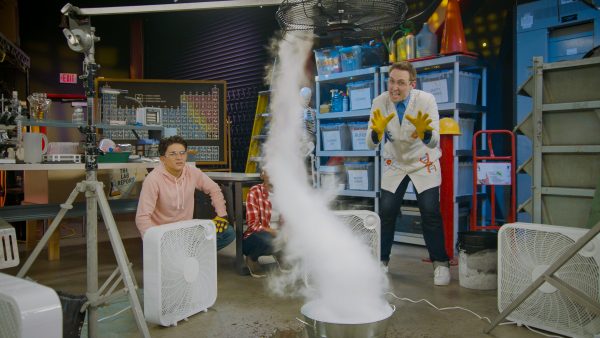Tsunami Definition
A tsunami is a series of huge waves from an ocean floor earthquake. For example, these waves cause damage when reaching coastal areas.
View Lesson on Predicting Natural Disasters
Become a member to get full access to our entire library of learning videos, reading material, quiz games, simple DIY activities & more.
Become a member to get full access to our entire library of learning videos, quiz games, & more.
Plans & Pricingto watch this full video.

Access All Videos
and Lessons, No Limits.
Access All Videos

No credit card required,
takes 7 sec to signup.
No card required

Ready-to-go lessons
that save you time.
Ready-to-go lessons
If you are on a school computer or network, ask your tech person to whitelist these URLs:
*.wistia.com, fast.wistia.com, fast.wistia.net, embedwistia-a.akamaihd.net
Sometimes a simple refresh solves this issue. If you need further help, contact us.
Predicting Natural Disasters
Fun Facts
- Tsunamis can occur all over the world and reach speeds of up to 500 miles per hour.
- When an earthquake occurs on the ocean floor, massive wave systems rush in various directions from the earthquake.
- Seismologists use data from past earthquakes to predict future events, but have not yet figured out how to determine when and where an earthquake will occur.
Why Do We Need To Know About Tsunami
Learning about tsunamis helps us see how scientists and engineers work together to make them less harmful. Engineers build strong structures and create systems to warn us before a tsunami hits. Scientists, like those who study earthquakes and volcanoes, help predict when a tsunami might happen to save lives.
This teamwork not only makes us better prepared for natural disasters, but also shows how important science and engineering jobs are in helping us stay safe. By studying tsunamis, we understand how using knowledge from different areas, like earth science and building design, can help protect people and lessen the damage caused by these big waves.
Frequently Asked Questions
Check out the Full Lesson on Predicting Natural Disasters
In this lesson, we learn that:
- We can't stop natural disasters from happening, but we can reduce their impact.
- Some disasters like tornadoes can be forecasted to give people warning.
- Other natural disasters like earthquakes are not yet predictable.
Related Topics
- Atom Definition
- Chemical Change Definition
- Chemical Reaction Definition
- Circulatory System Definition
- Competition Definition
- Conservation Biologist Definition
- Definition Of Shade
- Digital Signal Definition
- Earth’s Rotation Definition
- Electromagnet Definition
- Electromagnetic Radiation Definition
- Engineer Definition
- Engineering Design Process Definition
- Environmental Factors Definition
- Food Chain Definition
- Fresh Water Definition
- Friction Definition
- Gas Definition
- Greenhouse Effect Definition
- Habitat Definition
- Hydrosphere Definition
- Insulator Definition
- Internal Structures Definition
- Invasive Species Definition
- Light Definition
- Lunar Eclipse Definition
- Material Definition
- Mitochondria Definition
- Moon Definition
- Natural Disaster Definition
- Newton’s 1st Law Of Motion Definition
- Nucleus Definition
- Opposable Thumb Definition
- Organelle Definition
- Period Definition
- Phases Of The Moon Definition
- Push Definition
- Rock Definition
- Simple Machines Definition
- Solar System Definition
- States Of Matter Definition
- Symbiosis Definition
- Trace Fossil Definition
- Transverse Wave Definition
- Tsunami Definition
- Water Cycle Definition
- Watershed Definition
- Weight Definition
Start a Free Trial Today. Get a $5 Amazon Gift Card!
Teachers! Start a free trial & we'll send your gift card within 1 day. Only cards left. Try it now.
Select Grade
Select Subject
This email is associated with a Science Kit subscription. Kit subscriptions are managed on this separate page: Manage Subscription

-
Download InvoiceScience & Math$/yr
-
Download InvoiceScience Only$/yr

access all lessons
• No credit card required •
"My students loved the videos. I started the video subscription in May and used them as a review before the state test, which I know contributed to 100% of my class passing the state test."
Rhonda Fox 4th Grade Teacher, Ocala, Florida
• No credit card required •
"My students loved the videos. I started the video subscription in May and used them as a review before the state test, which I know contributed to 100% of my class passing the state test."
Rhonda Fox 4th Grade Teacher, Ocala, Florida
• No credit card required •
Already a member? Sign In
* no credit card required *

* no credit card required *
* no credit card required *


no credit card required
Skip, I will use a 3 day free trial
Enjoy your free 30 days trial
-
Unlimited access to our full library
of videos & lessons for grades K-5. -
You won’t be billed unless you keep your
account open past your 14-day free trial. -
You can cancel anytime in 1 click on the
manage account page or by emailing us.
-
Unlimited access to our full library of videos & lessons for grades K-5.
-
You won't be billed unless you keep your account open past 14 days.
-
You can cancel anytime in 1-click on the manage account page.
Cancel anytime in 1-click on the manage account page before the trial ends and you won't be charged.
Otherwise you will pay just $10 CAD/month for the service as long as your account is open.
Cancel anytime on the manage account page in 1-click and you won't be charged.
Otherwise you will pay $10 CAD/month for the service as long as your account is open.
We just sent you a confirmation email. Enjoy!
DoneWe use cookies to make your experience with this site better. By using this site you agree to our use of cookies. Click "Decline" to delete and block any non-essential cookies for this site on this specific property, device, and browser. Please read our privacy policy for more information on the cookies we use.Learn More
We use cookies to improve your experience. By using this site, you agree to our use of cookies. Click "Decline" to block non-essential cookies. See our privacy policy for details.Learn More




























































































































